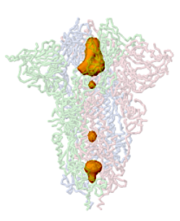Cavity programs
From Proteopedia
(→Jmol) |
(→Jmol) |
||
| Line 7: | Line 7: | ||
==Jmol== | ==Jmol== | ||
<table align="right" width="350" cellpadding="5" style="border: 1px solid black; border-collapse:collapse;"><tr><td> | <table align="right" width="350" cellpadding="5" style="border: 1px solid black; border-collapse:collapse;"><tr><td> | ||
| - | Interior (buried) cavities in the [[SARS-CoV-2 spike protein]] rendered as isosurfaces by Jmol using a cavity probe radius of 2.6 Å and a surface smoothing probe radius of 10 Å. | + | <span style="font-size:120%; font-weight:bold;">Jmol:</span><br>Interior (buried) cavities in the [[SARS-CoV-2 spike protein priming by furin|SARS-CoV-2 spike protein]] rendered as isosurfaces by Jmol using a cavity probe radius of 2.6 Å and a surface smoothing probe radius of 10 Å. |
</td><td> | </td><td> | ||
[[Image:Jmol-cavities-6zgi.png|180px]] | [[Image:Jmol-cavities-6zgi.png|180px]] | ||
Revision as of 20:49, 15 December 2020
This page lists programs that identify and offer visualization options for cavities in macromolecules. Broadly, the term "cavities" includes pockets, tunnels and channels. A pocket is a depression in the surface with one entrance. A tunnel connects two or more locations, and may or may not have entrances from the surface[1][2]. Some cavities are buried with no entrances from the surface (example: 3drf).
Nearly all proteins have irregular surfaces with shallow pockets, mostly with no known functions. Some proteins have deep pockets, for example the catalytic anionic gorge in acetylcholinesterase (e. g. 1vot). Such a pocket can also be termed a tunnel accessing the catalytic site[1][2].
Programs are listed alphabetically.
Jmol
|
Jmol: |
Jmol can identify and display pockets and cavities as isosurfaces. Examples are shown at Jmol/Cavities pockets and tunnels, where you will also find explanations of the interior cavity and pocket commands.
References
- ↑ 1.0 1.1 Marques SM, Daniel L, Buryska T, Prokop Z, Brezovsky J, Damborsky J. Enzyme Tunnels and Gates As Relevant Targets in Drug Design. Med Res Rev. 2017 Sep;37(5):1095-1139. doi: 10.1002/med.21430. Epub 2016 Dec 13. PMID:27957758 doi:http://dx.doi.org/10.1002/med.21430
- ↑ 2.0 2.1 Kingsley LJ, Lill MA. Substrate tunnels in enzymes: structure-function relationships and computational methodology. Proteins. 2015 Apr;83(4):599-611. doi: 10.1002/prot.24772. Epub 2015 Feb 28. PMID:25663659 doi:http://dx.doi.org/10.1002/prot.24772

